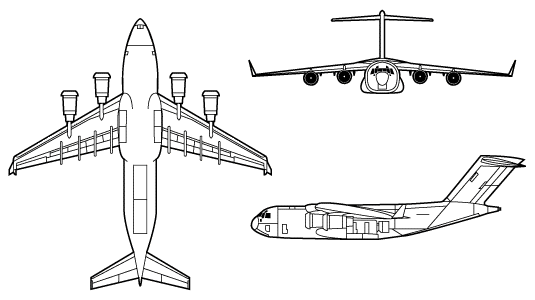The C-17 Globemaster III aircraft has four fuel-efficient turbofan engines which are integrated with a swept wing that uses superficial airfoil technology and winglets to provide intercontinental range with heavy payloads.
The C-17 is specifically designed and has the ability to transport all types and large quantities of military fighting equipment and associated personnel.
When the need is urgent and the terrain or the enemy will not let the airlift aircraft land, when surprise is essential,
or when it is important to get troops and equipment on the ground quickly, the C-17 can employ whatever airdrop option is needed.
The cargo compartment is designed to permit safe and efficient operation with one loadmaster
for any mission. The aircraft accommodates outsize or oversize cargo, tactical vehicles,
container loads (which can be configured to conduct a combination of airland, personnel
and equipment airdrop), and MEDEVAC operations. The C-17A can be configured with
or without a comfort pallet. The jump platforms and air deflectors are an integral part of
the aircraft fuselage. A dedicated antenna system enables use of organic Army tactical
satellite (TACSAT) communication systems en route.
At no time during airborne operations should the cargo ramp door be open when the troop doors are open.
The peacetime ACL (allowable cargo load) of the C-17 based on 3,500 NM is 135,000 pounds and the wartime ACL of the C-17 based on 2,500 NM is 170,900 pounds.
| Palletized Cargo |
|---|
| Double-Row Logistics System | 18 pallets |
| Single-Row Aerial Delivery System | 11 pallets |
| Passengers |
|---|
| Side wall seats | 54 |
| Center seats (additional seat kit) | 48 |
| Paratroops | 102 |
| Maximum on over water flights | 102 |
| Helicopters |
|---|
| AH-1 | 4-6 |
| AH-64 | 4 |
| CH-47 | 0 |
| OH-58 | 7 |
| UH-1 | 4-6 |
| UH-60 | 4 |
| Patriot Guided Missile System |
|---|
Seven aircraft for one Minimum Engagement Package:
Two launchers, radar station, support vehicles, supplies,
and personnel to sustain operations for 15 days. |
USA.

